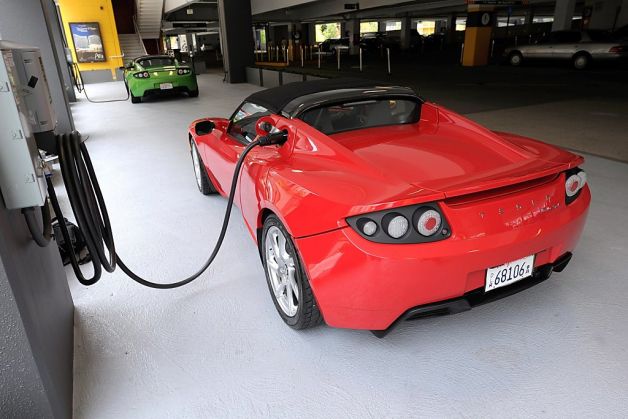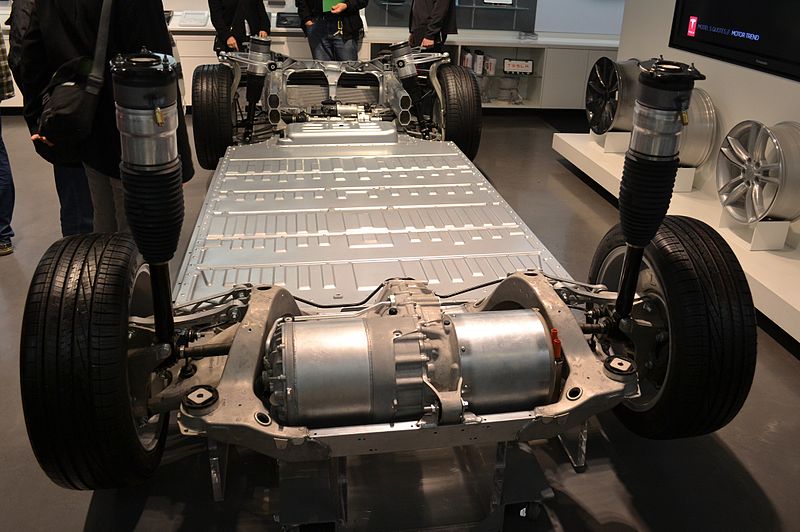On the threshold of the boom of electric vehicles: Tesla Motors made a profit
Tesla Motors, led by Elon Musk , showed profit for the first time in the first quarter of this year. During this quarter, 5000 electric vehicles were sold. Tesla Motors cars belong to the premium class: Tesla Roadster costs $ 109,000, Model S - $ 70,000. In early May, the company lured away Aston Martin’s lead engineer Chris Porrit - he now occupies Tesla as vice president of design and technology. Against the background of good news, Tesla Motors stock price has more than doubled in the last three months.

According to the quarterly report, Tesla Motors profit margin is high even if you subtract government subsidies for green cars. The company is rapidly optimizing production - over the past few months, it has been possible to reduce the time spent on creating one electric vehicle by 40%. According to Elon Mask, the cost of production of batteries - one of the main components of the price of an electric vehicle - should also be reduced by 30% - 50% in the foreseeable future. He claims that in the next three to four years, an electric car may appear at a price of $ 30,000.
In the meantime, a more or less decent network of electric filling stations has already been created in the USA. Now there are almost 6,000 of them and 180 new ones open every month. On one charge, the Tesla Model S can drive about 330 kilometers, so that where the network of gas stations is fairly dense, for example in California, you can move almost freely on an electric car. Electric filling networks are also being established in other countries - Israel, Estonia, Switzerland.
')
As the infrastructure develops, an electric car or a hybrid with the possibility of charging from the network turns from a toy into a tool that is quite useful in the household. Its huge capacity of a dozen or so kilowatt hours in hybrids up to 85 kWh in top Tesla models allows it to be used as a backup power source for the home. So, Nissan has already demonstrated the ability to use Nissan Leaf batteries to power a whole house for a couple of days. And General Motors proposes to use the Chevrolet Volt batteries that have served their time to create powerful bespereboynik 25 kWh. This is possible due to the fact that the hybrid battery is considered unsuitable when its capacity is reduced to 70%. For a car, this means a serious reduction in the distance of the trip, which is unacceptable. But you can use the battery further - it is more profitable than immediately dispose of it.

Tesla Model S from the inside. All the bottom of the car takes the battery.
In addition, an electric car or plug-in hybrid greatly reduces the payback period of individual alternative power plants - solar panels or wind turbines. For example, journalist Kevin Tofl recently published calculations on the Gigaom website showing how the purchase of a Chevrolet Volt reduced the payback period of its solar panels by almost half, to 6 years.
PS : The comments quickly scored a lot of advantages the question of how much will have to increase global electricity production, if the entire vehicle goes to electricity. I have the answer, since on this topic recently there was a topic on Habré. In the topic itself, a rather dubious method of calculation was used, but in the comments several people (including me) independently estimated each other using different methods or googled the statistics and it turned out that in order to fully convert the entire fleet into electricity, it would be necessary to increase its global production twice.
These comments: №1 , №2 , №3 , №4 .

According to the quarterly report, Tesla Motors profit margin is high even if you subtract government subsidies for green cars. The company is rapidly optimizing production - over the past few months, it has been possible to reduce the time spent on creating one electric vehicle by 40%. According to Elon Mask, the cost of production of batteries - one of the main components of the price of an electric vehicle - should also be reduced by 30% - 50% in the foreseeable future. He claims that in the next three to four years, an electric car may appear at a price of $ 30,000.
In the meantime, a more or less decent network of electric filling stations has already been created in the USA. Now there are almost 6,000 of them and 180 new ones open every month. On one charge, the Tesla Model S can drive about 330 kilometers, so that where the network of gas stations is fairly dense, for example in California, you can move almost freely on an electric car. Electric filling networks are also being established in other countries - Israel, Estonia, Switzerland.
')
As the infrastructure develops, an electric car or a hybrid with the possibility of charging from the network turns from a toy into a tool that is quite useful in the household. Its huge capacity of a dozen or so kilowatt hours in hybrids up to 85 kWh in top Tesla models allows it to be used as a backup power source for the home. So, Nissan has already demonstrated the ability to use Nissan Leaf batteries to power a whole house for a couple of days. And General Motors proposes to use the Chevrolet Volt batteries that have served their time to create powerful bespereboynik 25 kWh. This is possible due to the fact that the hybrid battery is considered unsuitable when its capacity is reduced to 70%. For a car, this means a serious reduction in the distance of the trip, which is unacceptable. But you can use the battery further - it is more profitable than immediately dispose of it.

Tesla Model S from the inside. All the bottom of the car takes the battery.
In addition, an electric car or plug-in hybrid greatly reduces the payback period of individual alternative power plants - solar panels or wind turbines. For example, journalist Kevin Tofl recently published calculations on the Gigaom website showing how the purchase of a Chevrolet Volt reduced the payback period of its solar panels by almost half, to 6 years.
PS : The comments quickly scored a lot of advantages the question of how much will have to increase global electricity production, if the entire vehicle goes to electricity. I have the answer, since on this topic recently there was a topic on Habré. In the topic itself, a rather dubious method of calculation was used, but in the comments several people (including me) independently estimated each other using different methods or googled the statistics and it turned out that in order to fully convert the entire fleet into electricity, it would be necessary to increase its global production twice.
These comments: №1 , №2 , №3 , №4 .
Source: https://habr.com/ru/post/179805/
All Articles